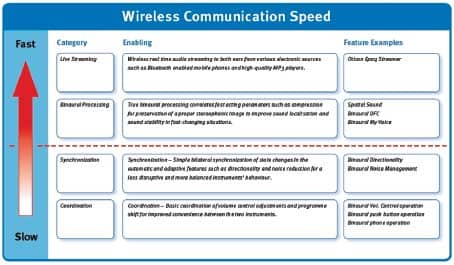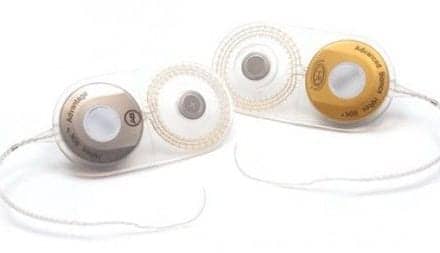Just as “digital” was the consumer buzz word of the ’80s and early ’90s, when seemingly everything became digitalized, “wireless” is the consumer trend of the moment. Incorporating wireless technologies into hearing instruments, however, has, until recently, been an afterthought rather than the very basis for the design of the microchip at the heart of the instruments. Recently, Oticon introduced the RISE microchip platform, which uses near-field magnetic induction (NFMI) wireless technology in virtually all aspects of the circuit’s performance.
Ideally, wireless technologies incorporated within hearing instruments should have extremely low power consumption and very small components. NFMI has these attributes and is a wireless technology uniquely suited to hearing instrument applications.
NEAR-FIELD MAGNETIC INDUCTION
NFMI wireless technology is rapidly expanding into applications such as two-way radios and hands-free mobile phone earpieces, and some hearing instruments.1 NFMI works on the principle of magnetic induction, which is somewhat similar to a telecoil. With NFMI, however, communication can be two-way and the signal can be encoded for security purposes. Two devices or components each generate a special magnetic field, and communication takes place via an interaction between the fields.
NFMI is ideal for incorporation within hearing instruments because the components are very small and the power needs are minuscule. When active, the NFMI circuit in the Oticon RISE platform increases the power consumption of the chip by only 10%. Additionally, the magnetic field of the system does not extend beyond approximately 3 feet, which ensures secure encoded communication with a greatly reduced susceptibility to interference.
Until recently, hearing aids only made limited use of NFMI technology for basic applications such as bilateral control of the volume or program settings. Recent developments in the technology have allowed the transfer of information at speeds 100 times faster than before.

|
| Figure 1. The relationship between data-transfer speed and the domain being controlled. |
The NFMI technology used in Oticon’s RISE platform is called EarStream. Running at 120,000 bits per second, it is comparable to the speeds in entry-level ADSL and cable Internet modem connections commercially available today. EarStream makes many applications possible, including true binaural processing and real-time audio streaming to the hearing aids from external devices. (See Figure 1 above.)
When applied in Oticon’s new Epoq hearing instrument, the technology essentially redefines the role of amplification. New binaural processing schemes enable the Epoq hearing instrument to restore rather than reduce important binaural sound cues used by the auditory system to facilitate localization and understanding in noise. The Epoq user experiences a richer and more natural soundscape, while the “costs” associated with certain technologies, such as compression and directionality, are reduced. This high-speed, binaural algorithm allows the dispenser to fit the auditory system as opposed to treating each ear individually. For the first time, hearing instruments can be truly fitted binaurally rather than just bilaterally.
SPATIAL SOUND
By using a paired set of detectors and analyzers, and implementing specific processing rules designed to enable two hearing aids to communicate with each other, EarStream makes a pair of instruments work as one to help maintain a proper interpretation of the location of various sounds in the environment—what we term “spatial sound.” The instrument coordinates the action of the directional, noise-reduction, feedback-cancellation, and compression systems to provide the brain with a preserved set of cues enabling it to re-create the world of sound around the listener.
 |
| Figure 2. The interaural spectral differences for sounds arising from various azimuths to the right of the midline (adapted from Sensimetrics Corp, 2003). Positive values indicate higher levels in the right ear than the left. |
As shown in Figure 2, the head creates spectral differences between the ears when sound does not arise from the midline.2 These spectral differences are essential for localization. The natural tendency of WDRC compression systems is to minimize these differences, because the gain applied to the signal is greater for lower-level input signals. A naturally occurring ear-to-ear difference of 10 dB can be reduced to 3 to 4 dB or less with the moderate amount of compression typical of WDRC fittings for moderate hearing loss.
The spatial sound feature of Epoq compares the inputs to the two hearing aids and adjusts the compression response to maintain precise spectral difference in the high frequencies. The effect is to provide the central auditory system a paired set of inputs that more accurately reflects the actual difference between the two ears.
In Epoq, the broadband binaural processing is also applied to other environmentally adaptive signal processing systems. When instruments act independently, the noise-reduction and directional systems constantly evaluate the environment and adjust the settings of the adaptive systems to the conditions experienced by the hearing aids.3 Since conditions can be different on either side of the head, hearing aids can make different decisions for each side.
Sometimes this makes sense, but it can also lead to different system responses in one ear versus the other, which can be confusing for the brain. It creates the impression of something different happening on one side as opposed to the other when the brain’s job is to create a unified perception. On the other hand, there are certain listening environments (eg, driving a car with the window open) where coordination does not make sense.
The spatial sound system in a pair of Epoq hearing aids coordinates the response of these systems. This allows improved sound quality, because the instrument avoids situations where one aid lags behind the other in decision-making, resulting in poor sound quality due to uncoordinated mode shifts.4 In highly asymmetrical situations, an artificial intelligence–based technology ensures that the two hearing aids work separately.

|
| Figure 3. The Streamer interface device can convert a Bluetooth signal to NFMI and transmit it to an associated pair of hearing instruments. |
Binaural sharing of information also increases the robustness of the detector systems. For instance, the Epoq hearing instrument can determine if the wearer is speaking. Synchronizing this own-voice detection system between the two ears significantly reduces the chance of false own-voice detection, which can occur when another person whispers or talks close to the wearer’s ear. Similarly, binaural synchronization is used to control the dynamic feedback-cancellation system in Epoq to minimize false positives and artifacts from external pure tone sources such as music.
In summary, broadband ear-to-ear communication helps ensure that the listener continues to benefit from the effects of advanced processing systems without experiencing reduced sound quality due to noncoordinated processing. Spatial sound (ie, coordinated compression) maintains the natural arrangement of sounds and natural contrasts and asymmetry in the sound scene.
MAKING THE CONNECTION
Wireless technologies—such as FM, where remote microphones with FM transmitters send a signal directly into a hearing aid—have long been associated with improving performance when background noise or distance is a problem. Widespread adoption of this technology within hearing aids has not occurred, however, partly due to the size, power consumption, and high cost associated with FM technology.
Bluetooth® technology is a type of shortwave radio signal developed to facilitate data and voice/audio transfer among devices, and it has become the de facto wireless standard commonly employed in everyday communication devices. Although much cheaper than FM, Bluetooth uses far too much power, and Bluetooth chips are too large to be built directly into hearing instruments in their current form. However, a gateway device can be used to bridge this gap and provide access to Bluetooth signals.
The EarStream feature creates a wireless zone, or “body area network,” around each hearing aid. Introducing a gateway device into this zone enables the Epoq hearing aids to receive external signals from all manner of external devices. The small, body-worn gateway device used with Epoq hearing aids is called Streamer. (See Figure 3.)
 |
| Figure 4. With Streamer, the signal from a Bluetooth cell phone can be transmitted to a pair of hearing instruments wirelessly. The user’s voice is also wirelessly transmitted back to the cell phone. |
Streamer converts Bluetooth wireless signals (and hard-wired inputs) into an NFMI signal that can be received by the Epoq hearing instruments. This effectively transforms a pair of Epoq hearing aids into a pair of tiny cordless headsets. In doing so, Streamer overcomes the interference problems associated with using digital hearing aids and cell phones. The Epoq user can now hear the telephone in both ears at the same time—without feedback or interference. The built-in microphone in Streamer picks up the user’s voice, enabling hands-free communication; the cell phone can remain in the user’s pocket. In other words, the Epoq user (BTE and ITE wearers) has the equivalent of a hands-free Bluetooth headset on both ears at all times, without having to attach any devices to the ear and without any cables. (See Figure 4.)
Streamer can also connect the hearing aids to different audio sources for entertainment or information purposes. In addition to Bluetooth signals, Streamer accepts any audio signal that can be accessed via a direct wired connection, allowing for a direct audio connection to MP3 players, televisions, radios, etc. (See Figure 5.) Alternatively, inexpensive Bluetooth adaptors can be connected to these devices and used to transmit the signal to the Streamer wirelessly.
 |
| Figure 5. A diagram showing the possible connection of Epoq hearing aids via Streamer to various external sound sources. |
GLIMPSING THE FUTURE
Wireless technology will become a dominant feature in hearing instrument technology over the next few years. This technology has great potential to improve the performance of binaurally fitted hearing instruments by providing wearers with better access to the localization cues employed by normal-hearing people. In addition, wireless technology will let people who are hearing impaired overcome the barriers they have faced with devices such as cell phones, MP3 players, navigation devices, and others.
REFERENCES:
- Aura Communications. Near-field magnetic communication properties. Available at: www.auracomm.com/Downloads/webwireless.pdf. Accessed June 11, 2007.
- Yost W. Fundamentals of Hearing: An Introduction. San Diego: Academic Press; 1994.
- Schum D. Artificial intelligence: the new advanced technology in hearing aids. Audiol Online. 2004.
- Keidser G, Rohrseitz K, Dillon H, et al. The effect of multi-channel wide dynamic compression, noise reduction, and the directional microphone on horizontal localization performance in hearing aid wearers. Int J Audiol. 2006;45:563-579.
Gordon Wilson, MBA, is vice president of marketing for Oticon Inc. Wilson has held a number of positions within Oticon since joining the company. George Lindley, PhD, AuD, is manager of Distance Learning for Oticon Inc. He is also an adjunct professor in the PCO School of Audiology. Don Schum, PhD, CCC-A, is vice president of Audiology and Professional Relations for Oticon Inc. Schum has more than 18 years of extensive background in clinical, educational, and research audiology. For more information, write to .





